If you’re reading this, it could mean you’re subscribed to our blog, and maybe you’re thinking that we’re back in Colombia again! I wish that was true but actually we’re still in the UK and right now, during the pandemic, it’s hard to imagine when we’ll get to go back. We know that it has been nearly 3 years since our visit to the Amazon but we’ve realised that there are 3 blog posts that we started but never actually finished! The thing is that Brae and I wrote this page when we got back but then we needed Mum to find the photos and videos. Some of you may know that my mum started her teacher training just when we got back from Colombia and she had to work REALLY hard all year. Because she was working every night and every weekend she didn’t have time to sort out the photos so the blog got forgotten for all this time. While we’re self-isolating this week, we thought it would be a good thing to do to finish off the blog finally so that all of our Amazon experiences are captured.
Another reason why we really want to finish it is that Brae and I have both been reading the blog from our first Colombia trip recently. We were only 8 and 10 years old when we went there and I don’t think we really realised how unusual and special an experience we were having at the time. When we read the blog now I remember all the amazing things that we did that have slipped to the back of my mind. It has been great to refresh my memory about all these astonishing things I did. I would really love to remember these two trips for the rest of my life and this blog is a great way to record the things I have done and also share it with other people.
So, to remind you where we’d got to…
So far we’ve told you about amazing animals and creepy crawlies in the Amazon, and I suppose we were expecting both these things. But our Amazon trip also brought us a few surprises, which we want to tell you about too. Here are the top 5 bonus things that we weren’t expecting.
Number 1. Brazil and Peru.
By Oren:
At the bottom of the map of Colombia (Colombia is the orange part in the top picture below), you can see an extra strip of land that sticks out, heading even further south. At the southernmost point of this bit is the Amazon, and two other countries border the river here, very close together. They are Brazil and Peru.
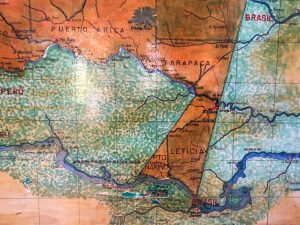

The town of Leticia in Colombia, where we first saw the Amazon, merges into another town called Tabitanga, which is actually in Brazil. You might expect there to be border control where the two countries meet, 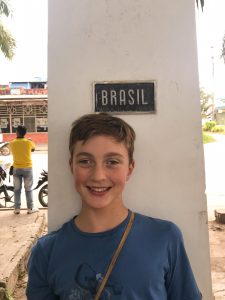 but no – instead there is a small white pillar with Colombia written on one side of it and Brazil on the other. We even stood with one foot in each country! It was so strange because you could have passed the pillar without noticing it, but pretty soon you’d become aware that all of the signs are in Portuguese and all the prices are in Brazilian currency! We couldn’t read them (except my mum because she had learnt a lot of Portuguese).
but no – instead there is a small white pillar with Colombia written on one side of it and Brazil on the other. We even stood with one foot in each country! It was so strange because you could have passed the pillar without noticing it, but pretty soon you’d become aware that all of the signs are in Portuguese and all the prices are in Brazilian currency! We couldn’t read them (except my mum because she had learnt a lot of Portuguese).
We were really keen to have lunch in Brazil and we went to a kind of serve-yourself buffet of traditional food. It was a really nice lunch – a good taste of Brazilian food. It was fairly similar to Colombian food; LOTS of meat and river fish! After that we went shopping for Brazilian football tops and flip flops. The dock on the bank of the river was pretty too because all of the jetties and boat houses were on logs so they could float when the river rose. People were arriving in boats to bring things to sell in the market. You can see all the bunches of bananas in the picture. All in all, it was a good day in Brazil. I really hope we can go back to Brazil some time, and really get a chance to explore, because I think it must be an amazing country. Also, my auntie and my cousins are half Brazilian so maybe we will go there with them one day.

The other country that connects to Colombia is Peru. Nearly 100 years ago, Peru and Colombia were fighting over the land north of the Amazon river, to see if it would belong to Peru or Colombia. In a peace treaty in 1922, it was agreed that Colombia could have a thin strip of land leading down to Leticia (the town where we stayed) so Colombian people could get to the Amazon, but Peru got most of the other land. When you are in Leticia, Peru is just the other side of the Amazon river from Colombia. I say just across the river, but this is actually quite a long way because the Amazon is so wide. They call the Amazon the River Sea because in the wet season it is so wide that when you look across the river it is like looking out to sea! In some places in Brazil it is 10 miles wide or even wider!
When we were in the Amazon we wanted to stay a night in Peru. We travelled by boat to the place where we were going to stay and when we went into Peru, again there was no border control.  We walked along a little jetty and onto Peruvian soil. The people just said ‘hola’ but they didn’t ask to see our passports. You can just see the Peruvian flag at the top of the slope. I found it quite weird seeing so many countries so close together because the UK is an island so it’s not like that. One of the other surprising things was when I realised that we were in the southern hemisphere. We weren’t far south of the equator – only just – but it was my first time and I hadn’t realised that we’d be going there so it felt like a unique experience. One of so many unique experiences that I was lucky enough to be having!
We walked along a little jetty and onto Peruvian soil. The people just said ‘hola’ but they didn’t ask to see our passports. You can just see the Peruvian flag at the top of the slope. I found it quite weird seeing so many countries so close together because the UK is an island so it’s not like that. One of the other surprising things was when I realised that we were in the southern hemisphere. We weren’t far south of the equator – only just – but it was my first time and I hadn’t realised that we’d be going there so it felt like a unique experience. One of so many unique experiences that I was lucky enough to be having!
Number 2. Tom, Justine, Petra, Hector and Monopoly deal.
By Oren:
As you might know, when we went to the Amazon we went with another family: Justine, Tom, Petra and Hector. Justine used to work with my mum in London. Since then her family has moved to France so it is difficult to meet up with them. Even when they are in the UK it is tricky to meet up as they usually go to London and Cambridge, not Norfolk. If you think about that then it is a bit crazy that we can meet up in the Amazon rainforest but not near where we live! It was really good to have people we knew to explore with, especially people we got along so well with.

When they were in Heathrow airport on their way to Colombia, they bought a last minute purchase of the game Monopoly Deal. They bought it as a game to play when it was raining or in the evenings. It is basically a travel version of Monopoly and it turned out to be one of the best purchases of the trip! We played it after every mealtime and it was very addictive – once you had played it you couldn’t stop. It got very tense at the end and I wonder if you can tell from the photos who usually won!
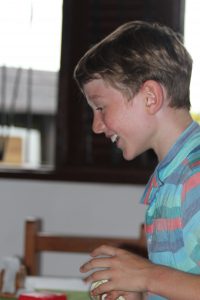

We bought the game for ourselves when we got back to the UK and over the last few years, every time we play it I think about being in the Amazon.
Number 3: Making bags.
By Brae:
While we were hiking in the jungle we made water bottle bags using palm leaves and the inside of palm trunks. The leaves were very easy to get but the trunk was harder because you had to use a machete to cut off the outer layer of the trunk and then cut off long thick strips of the inside. The strips were so tough that me and Oren working together couldn’t break them. We carried the materials with us until we got to the place where we were stopping for lunch and then, with the help of our guide Alberto, Oren, Hector and I made some water bottle bags.
Alberto showed us how to weave the palm leaves in and out of each other while carefully holding the leaves we had already done so they didn’t get tangled up. Once we had woven one side of the palm leaf we tied it up and started on the other side. The hard bit came after that – plaiting the two sides of the leaf together. Once we had done that we used the strips of trunk. First we tied it to one end of the plait and then the other to make a shoulder strap.



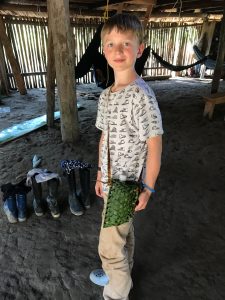
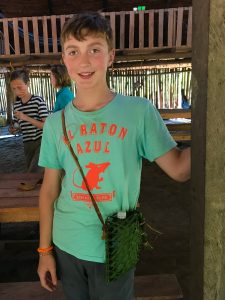
Once we had done all those things our bags were ready and I was especially surprised about how strong they were. Two days later at the monkey reserve even the monkeys couldn’t break them when they tried hard to investigate what was inside and if the bags tasted nice! For the rest of our time in the Amazon, we always had our bags with us. Because it was so hot, and because you can’t drink water from the tap, they were very useful. Alberto told us that one way to make them last longer was to dip them in the Amazon river every few days, so we made sure we did this.
As we’re only finishing this blog post nearly three years later, I can tell you that the bags are still just as strong as ever, even though it’s tricky to dip them in the Amazon regularly now!
Not surprisingly, the local people use materials from the jungle to make lots of things. On one of our hikes, we passed a man making panels for his roof. You can see how quick and skilled he was (we did not make it look this easy when we made our bags!!).
Most of the places we stayed had roof panels similar to the one that this man was making. In this video you see an example, although the panels have changed from green to brown as they dried. Even when it poured with rain, the roofs were completely waterproof!
Number 4. Indigenous communities and Colombian laws.
By Oren:
As you may know the Amazon is mainly inhabited by lots of indigenous tribes. While we were there we visited several different styles of indigenous settlement. For example Alfonso’s Annaneko (which means ‘house’ in his indigenous language) was one huge hut where lots of families lived together (and he was the chief). The last video where you can see the roof panels made of leaves is in Alfonso’s Annaneko. The hut symbolised the body of a god.
This was completely different from the Mocagua community that we saw near the Maikuchiga monkey sanctuary. Their village felt quite a lot more modern, with separate houses for each family, all arranged on the bank of the Amazon. All of the houses there were painted with designs about the jungle and the myths and legends that they told. The other main difference between them was how organised they were. Mocagua was very organised – we saw a notice board in the middle of the village which told you the dates each month when everyone in the village would work together to tidy the whole settlement to make sure there was no rubbish, and plant flowers and fix things. Their whole village was so pretty, whereas life in the Annaneko seemed quite strange to me.
Another community that we saw was at the edge of Puerto Nariño, which is one of the biggest towns in the region. We visited the school there and it looked really nice. I wouldn’t mind going to that school.
As Puerto Nariño is quite big it actually has a few different tribes and was a lot more modern. It is an eco friendly town and we really loved it and were told that it had progressed a lot in the last few years. There were no cars in the whole town so you just arrived by boat and then went on foot. This was fine most of the time but we saw some people trying to move really huge heavy things off boat to their houses at the top of steep hills and this was tricky without a car! A lot of the settlements we visited felt like you might imagine a jungle community to be – completely different from anything we’d ever seen – but Puerto Nariño wasn’t so dissimilar to other places we’d been in Colombia. It had electricity and shops and cafes. We loved just walking around and watching daily life and I’d like to go back there one day.
In this clip you can see a bit of the town and the classrooms are in the hexagonal huts. At the end you can see their view of the Amazon from the cool tower at the top of the hill.
We found out that the Colombian government has agreed that all the indigenous communities can make their own laws and deal with law breakers in their own ways, instead of following the normal Colombian laws. The tribes are really different from each other and make different laws for their communities. Often their laws and punishments are quite normal, but we did find out about one punishment that surprised us. It was putting an angry bullet ant down a man’s pants while he was tied to a tree. The bullet ant gets its name because its bite feels like you have been shot. Funnily enough he didn’t do the crime again. I wonder why!
I think that indigenous communities are very interesting and that it is great that the government lets them rule themselves. It is very good that they are still thriving well in the jungle.
Number 5: Brazil Nuts
By Brae:
In our family we eat a lot of Brazil nuts and it seems strange that we never even wondered how they grew. So another cool thing that happened when we visited Alfonso’s Annaneko is that we found out where Brazil nuts really come from. They basically grow inside a shell that looks a bit like a coconut. Surprisingly, all the nuts fit perfectly together in the inside, without even a single air pocket.
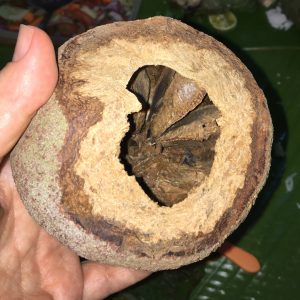
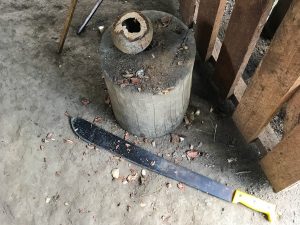

Justine really wanted to buy one like this because she thought they would make good presents, but we were told that we wouldn’t be able to find one like it to buy, because when they are shipped off to other countries no-one wants to pay for the extra weight so they take them out of the shell before they go anywhere. I guess not everyone has a giant machete lying around to open them either! All through our time in Colombia we saw fruits and nuts growing around us in ways that we never expected. It’s like the time we saw pineapples growing in little bushes and also when we realised that the coconut grew inside a huge green case. You can read about these things in some of our earliest blog posts. (Pineapple, Coconut).

A very nice surprise to read some Colombia blog posts on this Sunday morning O&B. You’ll get back there one day. Great stories!
Yeah, we hope we get back there one day too! Thanks for reading. Brae